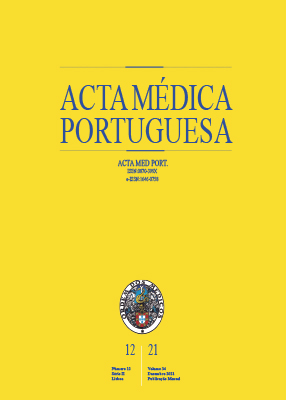Modelling the Contribution of Factors Influencing the Risk of SARS-CoV-2 Infection in Indoor Environments
DOI:
https://doi.org/10.20344/amp.15982Keywords:
Aerosols, Air Pollution, Indoor, COVID-19, Risk Factors, SARS-CoV-2, VentilationAbstract
Introduction: This study estimates the risk of aerosol infection by SARS-CoV-2 in indoor environments where high density of occupation results in an increased probability of infection, such as schools, offices, supermarkets, restaurants and gyms.
Material and Methods: In each type of building use, several conditions were simulated, such as the use and effectiveness of masks, ventilation, use of equipment that allows air asepsis using HEPA filters, the density of occupancy and the length of stay in the spaces, using a model based on the dispersion of aerosol particles in indoor spaces and on the accumulation and inhalation of these particles over time.
Results: The results showed that the replacement of social masks by masks with FFP2 classification decreased the risk of infection by 90% in schools. In schools with natural ventilation, the complete opening of windows reduced the risk of infection by 64% in comparison with the scenario with closed windows. In spaces where mechanical ventilation is normally used, the probability of infection decreased significantly when the regulatory fresh air flow rates were doubled (reduction of 32% in offices, 42% in restaurants, 24% in supermarkets and 46% in gyms). The filtration of air with HEPA filters allowed the reduction of the probability of infection by 72% in schools, offices, and restaurants and 61% in gyms. The length of stay in the spaces was also a relevant factor in the variation of the probability of infection, especially in schools where it was found that shorter classes with a higher number of intervals reduced the risk of infection.
Discussion: The results show the importance of adequate ventilation in indoor environments, especially in places where the density of occupation and the staying times are longer, making the introduction of outside air inside the spaces essential, either through natural or mechanical means. It is expected that the infection risk estimates presented are undervalued because the model only considers transmission by particles smaller than 10 μm and does not include the short-range transmission by assuming social distancing. Vaccination was not considered in the model since it was not yet available when the study was carried out.
Conclusion: The present study contributes to the identification of measures that decrease the risk of viral transmission, and consequently provide greater security in indoor spaces.
Downloads
Downloads
Published
How to Cite
Issue
Section
License
Copyright (c) 2021 Acta Médica Portuguesa

This work is licensed under a Creative Commons Attribution-NonCommercial 4.0 International License.
All the articles published in the AMP are open access and comply with the requirements of funding agencies or academic institutions. The AMP is governed by the terms of the Creative Commons ‘Attribution – Non-Commercial Use - (CC-BY-NC)’ license, regarding the use by third parties.
It is the author’s responsibility to obtain approval for the reproduction of figures, tables, etc. from other publications.
Upon acceptance of an article for publication, the authors will be asked to complete the ICMJE “Copyright Liability and Copyright Sharing Statement “(http://www.actamedicaportuguesa.com/info/AMP-NormasPublicacao.pdf) and the “Declaration of Potential Conflicts of Interest” (http:// www.icmje.org/conflicts-of-interest). An e-mail will be sent to the corresponding author to acknowledge receipt of the manuscript.
After publication, the authors are authorised to make their articles available in repositories of their institutions of origin, as long as they always mention where they were published and according to the Creative Commons license.









